curiosity
Latest

Peter Molyneux's new game is about pioneering
Web and smartphone game publisher Kongregate and Peter Molyneux's 22 Cans are teaming up to launch a new mobile game. The Trail is an Oregon Trail-style adventure title where players strap on a backpack and pioneer their way across an undiscovered wilderness. As they progress, they can collect items that can be used to craft weapons and tools that'll help them hunt down sources of food. That can then be traded with other explorers to build a fortune that'll enable you to settle down in a Deadwood-style community. It's available for Android and iOS devices, although it's yet to hit the latter's app store just yet for free, with in-app purchases.

Curiosity rover sends back stunning pics from Martian mountains
NASA's Mars Curiosity rover may have taken a little break earlier this summer, but the craft has been back at work and beamed some excellent images back to Earth late last week. Curiosity has been exploring the "Murray Buttes" region of Mount Sharp and send back color photos of what NASA Curiosity Project Scientist Ashwin Vasavada called "[a] road trip through a bit of the American desert Southwest on Mars." Indeed, these large color photos are evocative of what you might see down in Arizona or New Mexico.

Mars' veins were created by vanishing ancient lakes
Scientists just produced stronger evidence that Mars once had water lakes that might have nurtured life. After combing over Curiosity rover data, the researchers determined that veins in places like the planet's Gale Crater were likely created by evaporating lakes whose sediments were buried, heated and corroded. The discoveries also suggest that the water in these areas would have been habitable, if not exactly pleasant to drink -- it would have had about 20 times more sodium and sulphate than your bottled water back on Earth. There were likely "multiple generations" of water, NASA adds.
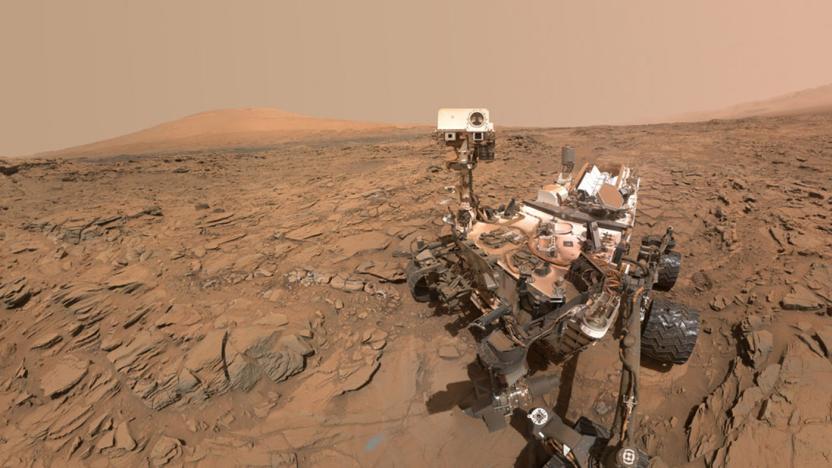
NASA celebrates Curiosity's fourth year on Mars with a game
The glitch that shut down Curiosity in July was thankfully a temporary issue, else NASA would have mourned its loss rather than celebrating the rover's fourth year on Mars by releasing a game. It's simply called Mars Rover, and it's probably your only chance to pilot Curiosity. Mars Rover has a pretty straightforward gameplay -- you just have to press arrow keys to drive the vehicle and find underground pockets of water -- but it's harder than it seems. The virtual rover's wheels crack and break if they slam hard against rocks or heels, and when they do, it's game over.
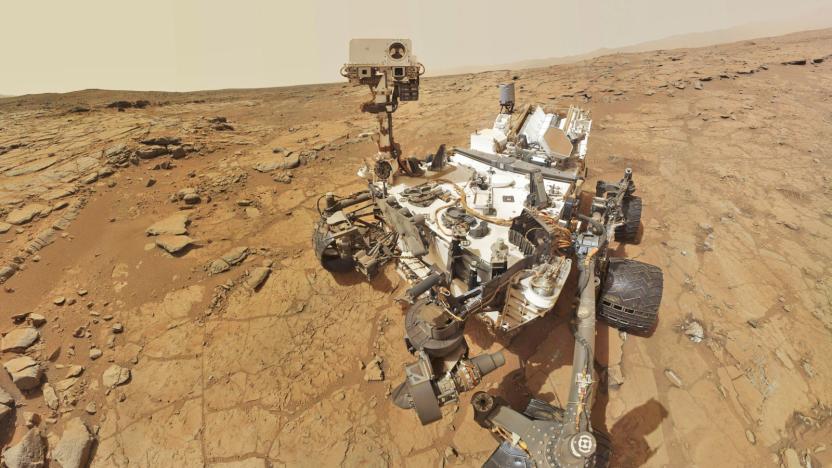
Curiosity rover can shoot lasers at any rock it wants
Is there anything cooler than sending a robot to Mars to shoot rocks with lasers? Probably not -- which is why NASA is giving the Curiosity rover the ability to shoot even more rocks with lasers. Okay, technically NASA is giving the Martian rover the ability to choose targets for ChemCam analysis. This is a process that uses a laser and telescopic camera to sort out the chemical composition of Martian rocks. Typically, NASA chooses the targets manually, but a new update will allow the rover to collect data autonomously.
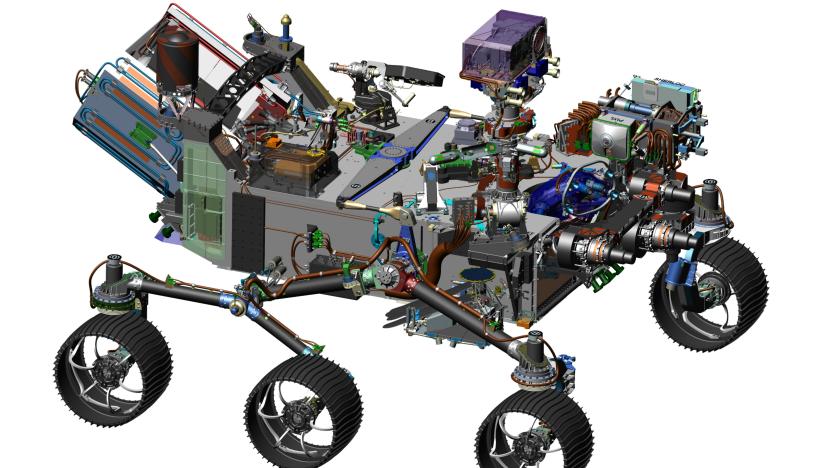
NASA's Mars 2020 rover will search for signs of past life
After building out its next Mars rover in mixed-reality simulations, NASA is ready to announce the near-final design that will depart for the red planet in the summer of 2020. Unlike Curiosity, which is still on its extended tour, the Mars 2020 rover will investigate an area of the planet searching for evidence of past life, with a long-term goal to carefully collect samples of Martian rocks and return them to Earth for further analysis.

Curiosity awakens from nap to resume full operations
Curiosity is back to work on Mars after it shut itself down due to a software glitch on July 2nd. Even though tech support for the rover is nearly 60 million miles away, NASA scientists weren't too worried about the issue. As suspected, the cause was found to be a "software mismatch in one mode of how image data are transferred on board." However, other means are available to transmit image data, so the team powered up the rover on July 9th and will simply avoid using the problematic mode.
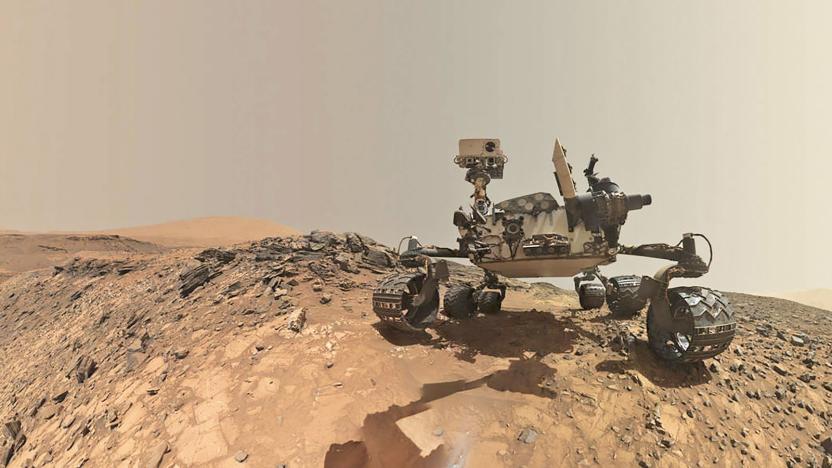
NASA's Curiosity rover took a 'safe mode' nap this weekend
On July 2nd, humanity's rugged little Mars explorer, Curiosity, automatically shut itself down and restricted most of its functions over the holiday weekend. Fortunately, scientists successfully secured communications with the rover, so all is not lost, and soon their diagnostics will reveal what went wrong.
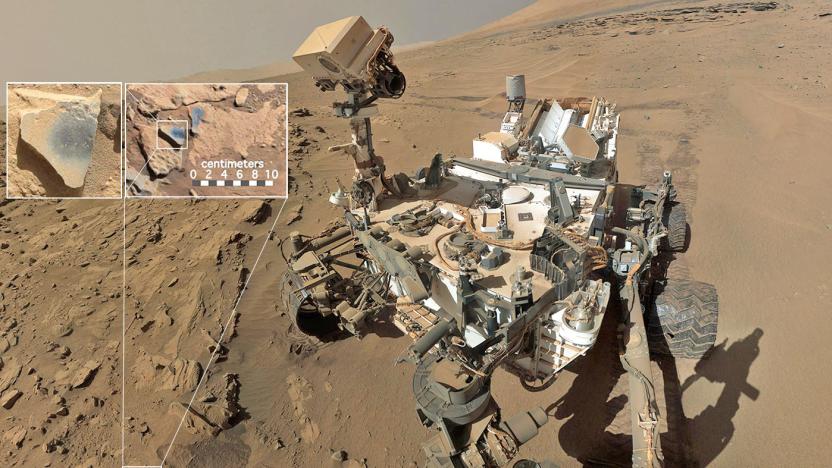
Curiosity finds evidence that Mars was once rich in oxygen
Mars may have had a much more Earth-like atmosphere rich in oxygen, according to JPL's Curiosity team. Using its laser-firing instrument in the Gale Crater, the intrepid rover found rocks with manganese oxide, which requires oxygen to form. On Earth, such minerals marked a period when our atmosphere became much more oxygen-rich, largely because of microbes. "Now we're seeing manganese oxides on Mars, and we're wondering how the heck these could have formed," says Los Alamos scientist Nina Lanza.
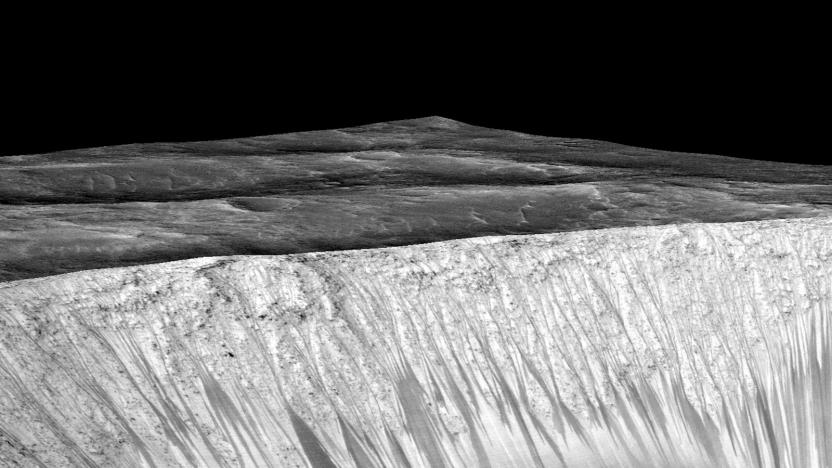
Curiosity rover may sample Mars water
Scientists have already found hints of liquid water on Mars... now, they want to take a close look at it. NASA has revealed that the Curiosity rover will investigate recurring slope lineae (those streaks you see above) around Mars' Gale Crater in hopes of finding water. It'll first take a photo with its mast camera to verify that there's water in the first place. If there is, the machine will head over to collect samples. The agency would like to take those photos within a year, so you wouldn't have to wait too long to get answers.
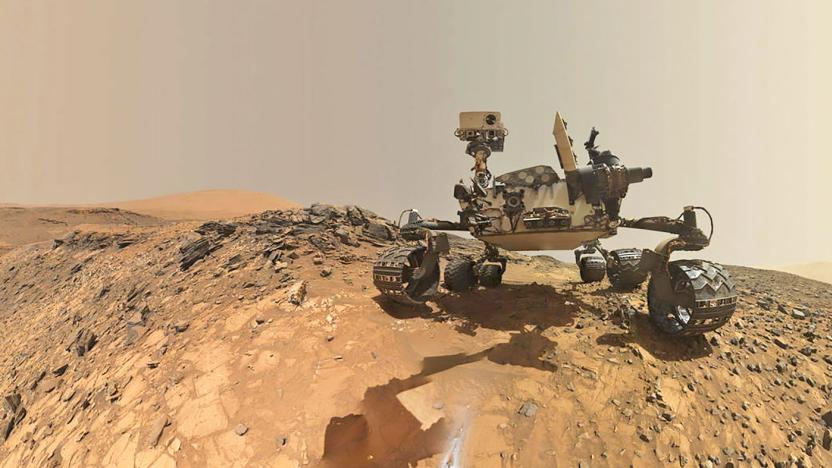
Mars may have had explosive volcanoes
The prevailing wisdom is that Mars has long been a stable planet. Without tectonic plates, it didn't have the violent upheavals that lead to earthquakes and explosive volcanoes here on Earth... did it? Not so fast. Scientists combing over data from NASA's Curiosity rover have found evidence suggesting that explosive volcanoes were a reality in the past. Samples from the planet's Gale crater include high concentrations of the mineral tridymite, which you tend to see around explosive volcanoes here on Earth. If so, the material was most likely carried from volcanoes to the crater by ancient water streams.

ICYMI: Barely hoverbiking, new hair dryer tech and more
#fivemin-widget-blogsmith-image-698312{display:none;} .cke_show_borders #fivemin-widget-blogsmith-image-698312, #postcontentcontainer #fivemin-widget-blogsmith-image-698312{width:570px;display:block;} try{document.getElementById("fivemin-widget-blogsmith-image-698312").style.display="none";}catch(e){}Today on In Case You Missed It: YouTuber Colin Furze teamed up with Ford to build a working hoverbike within just a few weeks, from his shed. It runs off of two diesel engines so granted, it's probably not the most mass-production friendly item, but does beg the question: What's holding everyone back, then?

Curiosity snaps a pic of the most rugged plateau it crossed
The Curiosity rover is almost done crossing the most rugged terrain it has ever crossed -- and of course it whipped out its trusty Mast Camera (Mastcam) to take a panorama for us Earthlings. Curiosity began its journey through the "Naukluft Plateau" in March, battling a sandstone bedrock full of sharp ridges. Naukluft, which is located in lower Mt. Sharp, got its distinct look from billions of years of wind erosion. The rover's ground team says the terrain didn't damage the vehicle's wheels more than it should, so it's still in good enough condition to reach its final destination.

An interview with one of NASA's Curiosity Rover engineers
With his Elvis haircut, his fondness for cowboy boots and the way he'll launch into soliloquies about big ideas like how to bend humanity toward collective self-improvement, Adam Steltzner might come off at first as some kind of hipster philosopher. That's one of the things that makes him such a memorable ambassador for NASA, his employer. Steltzner is in fact an engineer with an improbable combination of geek cred and California cool who this October will have spent 25 years working at NASA's Jet Propulsion Laboratory. He looks like a rock star -- plays bass guitar, in fact -- and can forcefully insist on humanity's imperative to explore the stars and to press against the limits of the known universe with little prompting.
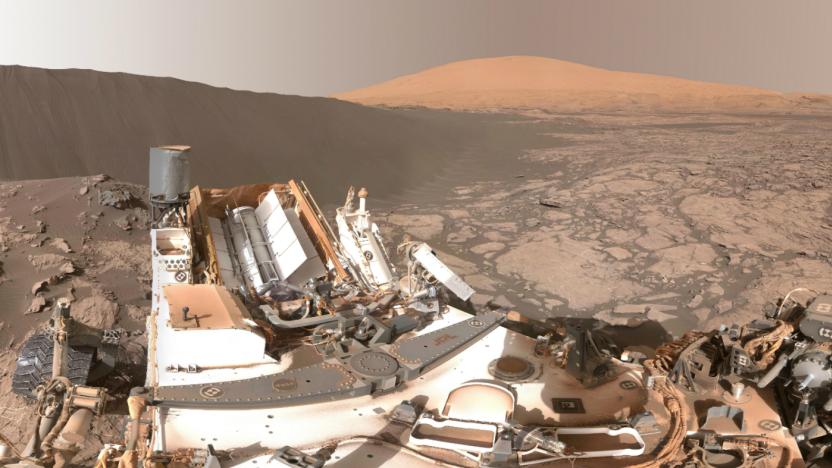
NASA's Curiosity offers another 360-degree peek at Mars
Less than two weeks ago NASA posted a 360-degree video on Facebook that showed the perspective of its Curiosity rover on Mars. It was an exhilarating view, but the way it had been created -- by stitching together lots of different photographs -- meant the final video offered a strange, fishbowl-like picture. Thankfully, NASA's Jet Propulsion Laboratory has uploaded a replacement to YouTube which is lightyears better than the original. While it's still a static shot -- so more of a panorama than a true 360-degree video -- it's another mesmerizing look at the Red Planet. The component images were captured by Curiosity on December 18, 2015 using the Mast Camera rig, otherwise known as Mastcam, which sits on top of the robot's vertical arm. In the video you can see the Namib Dune, which forms part of the Bagnold Dunes dotted along the northwestern flank of Mount Sharp. NASA notes that, after analysing images taken from orbit, scientists believe the dunes can move as much as one meter during a normal Earth year. A portion of Mount Sharp can be seen on the horizon and of course, Curiosity itself is visible down below on the surface. You can watch the video in your browser and click around to change the perspective, but for an immersive experience we recommend using the YouTube app on your phone or a Google Cardboard -- with the gyroscope sensor you can look around naturally, which is always pretty fun.
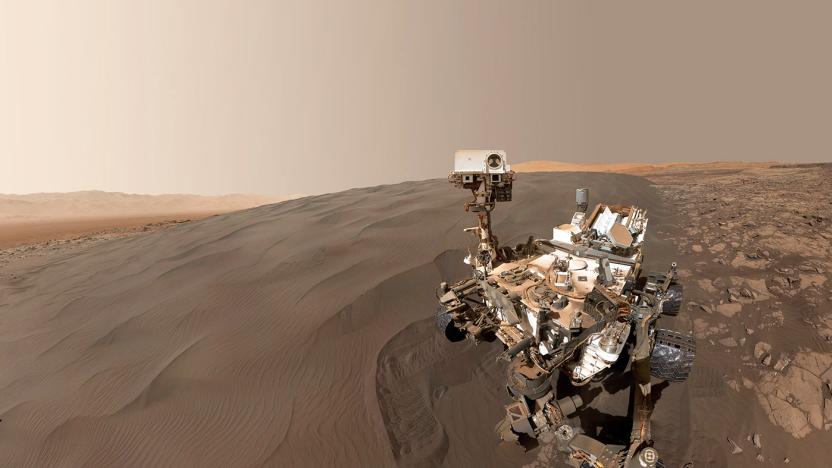
Curiosity rover takes a selfie on a Martian dune
Curiosity continues to explore the red planet almost four years since it landed in 2012. Over the course of its journey, it's taken the kind of selfies we don't mind seeing. Its latest self-portrait was captured at a place called "Namib Dune," part of a dark sand dune field northwest of Mount Sharp. What you see above is a composite of 57 images snapped on January 19th by the Mars Hand Lens Imager (MAHLI) attached to the end of the rover's arm -- think of it as a high-tech selfie stick.

New data suggests Mars had lakes that could have supported life
If you asked most star-gazers about water on Mars a month ago, you'd likely be told there is evidence for liquid H2O in the past, but it's probably long gone. How things can change. First was the big announcement that liquid water is still present (in some form). Now, new data from the Curiosity rover suggests there could have been a lot more of it than first thought, for longer periods of time, with the conditions needed to support life.

Our ongoing missions to Mars are over 50 years in the making
A deep space mission to Mars will require more than a few bottles of Poland Spring and water reclamation is a complicated business. Luckily, recent research is showing that liquid water may be more prevalent on the red planet than previously thought. Gathering the data that led to this discovery (amongst many others) didn't just happen overnight. It's the result of over 50 years' worth of missions from Earth with sights set on Mars, not all of which were successful. We've collected some highlights from humankind's long history of hurling spacecraft toward the fourth planet from the sun, and the good news is: We're getting better at it.

NASA enlists student help with Mars mission design challenge
Are you a college student? Want to be a part of NASA's mission to send astronauts to Mars? Well, you're in luck. The space agency has announced the Breakthrough, Innovative, and Game-changing (BIG) Idea Challenge that aims to get design help from university students. The challenge is to create a solution for slowing NASA's massive payload with inflatable spacecraft heat shields or hypersonic inflatable aerodynamic decelerator (HIAD) technology. While NASA managed to successfully land the Curiosity rover on Mars, a spacecraft with a crew on board would weigh between 15-30 tons -- slightly heavier than the rover's one-ton load. Couple that weight with the planet's thin atmosphere and you can understand why NASA needs to develop a new system to slow the vehicle's approach. What's more, NASA hopes that the HIAD tech could be used on other missions, too.

What petrified sand dunes look like on Mars
If you're the outdoorsy type, you might have already seen petrified sand dunes in person (in Utah, for instance) -- the photo above, however, isn't of a desert here on Earth. It's an image stitched together using several shots captured on August 27th by Curiosity rover's Mast Camera (Mastcam) on Mars. This sandstone formation originated as sand dunes formed by the wind, which eventually hardened and turned into rock. It's part of an area called the Stimson unit on Mount Sharp, which lies over a mudstone layer in what used to be a lake. The rover is investigating the location to determine how it changed from ancient times. This close-up image shows just a small part of the place, however: you can see the whole panorama NASA created on its website.











